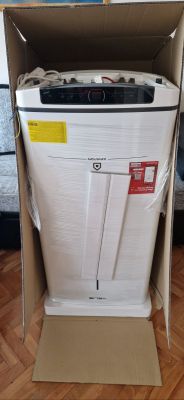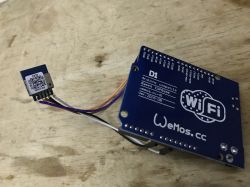Bought from here:
https://www.aliexpress.com/item/1005004762491352.html
Aliexpress page cache:
![[BKN7231N CBU] Universal remote control with temperature and humidity sensor [BKN7231N CBU] Universal remote control with temperature and humidity sensor](https://obrazki.elektroda.pl/2047711500_1678719525_thumb.jpg)
Almost same as https://www.elektroda.com/rtvforum/topic3933390.html, but with added temperature and humidity sensor
![[BKN7231N CBU] Universal remote control with temperature and humidity sensor [BKN7231N CBU] Universal remote control with temperature and humidity sensor](https://obrazki.elektroda.pl/8976250600_1678719333_thumb.jpg)
![[BKN7231N CBU] Universal remote control with temperature and humidity sensor [BKN7231N CBU] Universal remote control with temperature and humidity sensor](https://obrazki.elektroda.pl/9060892000_1678719375_thumb.jpg)
![[BKN7231N CBU] Universal remote control with temperature and humidity sensor [BKN7231N CBU] Universal remote control with temperature and humidity sensor](https://obrazki.elektroda.pl/3174906800_1678719401_thumb.jpg)
![[BKN7231N CBU] Universal remote control with temperature and humidity sensor [BKN7231N CBU] Universal remote control with temperature and humidity sensor](https://obrazki.elektroda.pl/1144628900_1678719421_thumb.jpg)
![[BKN7231N CBU] Universal remote control with temperature and humidity sensor [BKN7231N CBU] Universal remote control with temperature and humidity sensor](https://obrazki.elektroda.pl/2782040200_1678719491_thumb.jpg)
Used GPIO pins are:
P15 - Power IR receiver
P17 - Red LED
P9 - Green LED
P28 - Reset button
P24 - IR receiver input
P26 - Sensor SCL
P6 - Sensor SDA
P7 - Sensor Alert
P8 - IR send
Temperature and humidity sensor is CHT8305. Datasheet is here:
http://www.lanftek.com/Data/lanftek/upload/file/20180618/201802281014097175.pdf
![[BKN7231N CBU] Universal remote control with temperature and humidity sensor [BKN7231N CBU] Universal remote control with temperature and humidity sensor](https://obrazki.elektroda.pl/6359312600_1678719468_thumb.jpg)
https://www.aliexpress.com/item/1005004762491352.html
Aliexpress page cache:
![[BKN7231N CBU] Universal remote control with temperature and humidity sensor [BKN7231N CBU] Universal remote control with temperature and humidity sensor](https://obrazki.elektroda.pl/2047711500_1678719525_thumb.jpg)
Almost same as https://www.elektroda.com/rtvforum/topic3933390.html, but with added temperature and humidity sensor
![[BKN7231N CBU] Universal remote control with temperature and humidity sensor [BKN7231N CBU] Universal remote control with temperature and humidity sensor](https://obrazki.elektroda.pl/8976250600_1678719333_thumb.jpg)
![[BKN7231N CBU] Universal remote control with temperature and humidity sensor [BKN7231N CBU] Universal remote control with temperature and humidity sensor](https://obrazki.elektroda.pl/9060892000_1678719375_thumb.jpg)
![[BKN7231N CBU] Universal remote control with temperature and humidity sensor [BKN7231N CBU] Universal remote control with temperature and humidity sensor](https://obrazki.elektroda.pl/3174906800_1678719401_thumb.jpg)
![[BKN7231N CBU] Universal remote control with temperature and humidity sensor [BKN7231N CBU] Universal remote control with temperature and humidity sensor](https://obrazki.elektroda.pl/1144628900_1678719421_thumb.jpg)
![[BKN7231N CBU] Universal remote control with temperature and humidity sensor [BKN7231N CBU] Universal remote control with temperature and humidity sensor](https://obrazki.elektroda.pl/2782040200_1678719491_thumb.jpg)
Used GPIO pins are:
P15 - Power IR receiver
P17 - Red LED
P9 - Green LED
P28 - Reset button
P24 - IR receiver input
P26 - Sensor SCL
P6 - Sensor SDA
P7 - Sensor Alert
P8 - IR send
Temperature and humidity sensor is CHT8305. Datasheet is here:
http://www.lanftek.com/Data/lanftek/upload/file/20180618/201802281014097175.pdf
![[BKN7231N CBU] Universal remote control with temperature and humidity sensor [BKN7231N CBU] Universal remote control with temperature and humidity sensor](https://obrazki.elektroda.pl/6359312600_1678719468_thumb.jpg)






![[BKN7231N CBU] Universal remote control with temperature and humidity sensor [BKN7231N CBU] Universal remote control with temperature and humidity sensor](https://obrazki.elektroda.pl/7027272300_1678888725_thumb.jpg)
![[BKN7231N CBU] Universal remote control with temperature and humidity sensor [BKN7231N CBU] Universal remote control with temperature and humidity sensor](https://obrazki.elektroda.pl/8166399100_1678927815_thumb.jpg)
![[BKN7231N CBU] Universal remote control with temperature and humidity sensor [BKN7231N CBU] Universal remote control with temperature and humidity sensor](https://obrazki.elektroda.pl/2965800500_1679321189_thumb.jpg)
![[BKN7231N CBU] Universal remote control with temperature and humidity sensor [BKN7231N CBU] Universal remote control with temperature and humidity sensor](https://obrazki.elektroda.pl/9159154600_1679340367_thumb.jpg)